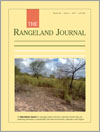RJ15130Impact of grazing system on rangeland condition and grazing capacity in Zimbabwe
The link between rangeland health and grazing system was evaluated in communal, small-scale and large-scale commercial farming systems of Zimbabwe. The communal grazing system was the most detrimental management system based on five key indicators. There is need to overhaul the existing communal grazing system in favour of a more sustainable rest-and-rotation system that gives defoliated plants time to recover.




